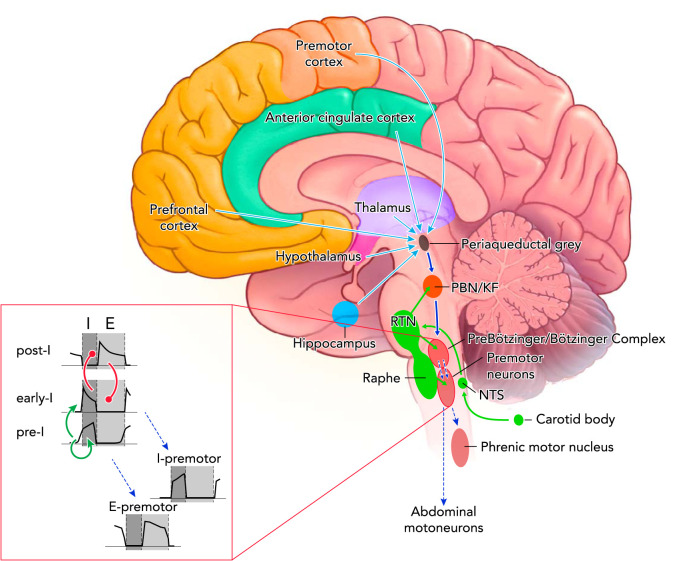FIGURE 1.
Excitatory connections within the respiratory control center and opioid effects
Tonic chemodrive (green solid arrows) is the main excitatory drive to the medullary rhythm generator. A large component of chemodrive is routed through the Parabrachial Nucleus/Kölliker-Fuse Complex to phase-switching neurons in the preBötzinger Complex and determines respiratory rate (dark blue solid arrow). Phasic inputs from the preBötzinger Complex activate inspiratory (I) and expiratory (E) premotor and motoneurons (blue dotted arrows). Respiratory motor output (tidal volume) depends on direct projections from the retrotrapezoid nucleus to preBötzinger Complex neurons, premotor neurons, and motoneurons. The cortico-limbic system contributes tonic drive to the medullary rhythm generator (light blue solid arrows). Not shown: direct projections from the motor cortex to phrenic motoneurons as a pathway to override automatic rhythm; projections from the hypothalamus and cerebellum to the medullary raphe, which may contribute to the state-dependency of respiratory activity. Opioid effects: Parabrachial Nucleus/Kölliker-Fuse Complex activity was depressed in all studies and at all opioid concentrations. Opioid-induced depression was also shown for the preBötzinger Complex, the nucleus of the solitary tract, and the medullary raphe. Opioid-induced sedation suggests depression of forebrain inputs. Premotor neurons are only directly depressed at very high opioid concentrations. Inset: neuronal subtypes constituting the core of respiratory rhythm generation. Through mutual excitation, network activity of pre-inspiratory neurons (pre-I) in the preBötzinger Complex results in activation of early inspiratory (early-I) neurons (green arrows). Activity of these neurons is terminated through inhibition by post-inspiratory neurons (post-I), which themselves are inhibited by early-I neurons during the inspiratory phase (red circles). Phasic excitation is relayed to inspiratory (I) and expiratory (E) premotor neurons.

